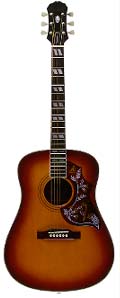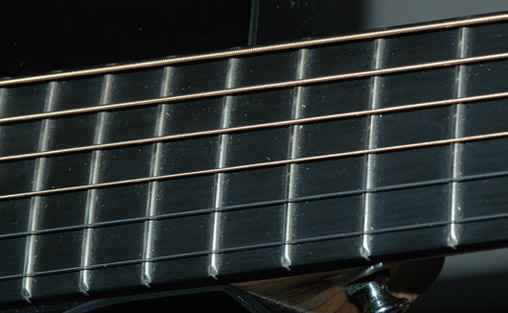Tuning the 6-String Guitar
A standard tuning for the strings of the guitar would be E2, A2, D3, G3, B3, E4, referring to the equal tempered set of notes based on A440Hz. They are usually numbered in the descending order (i.e., the E4 is called string 1). The strings are tuned a fourth apart except for the major third interval between strings 2 and 3.
Here is a basic procedure for tuning the guitar:
- Tune string 5 (A2) to 110 Hz using an electronic metronome or tuning fork, etc.
- Tune string 6 (E2) by depressing it at fret 5 (A2) and matching this pitch to the pitch of open string 6 (A2).
- Tune string 4 (D3) by depressing string 5 at fret 5 (D3) and matching these pitches.
- Tune string 3 (G3) by depressing string 4 at fret 5 (G3) and matching these pitches.
- Tune string 2 (B3) by depressing string 3 at fret 4 (B3) and matching these pitches.
- Tune string 1 (E4) by depressing string 2 at fret 5 (E4) and matching these pitches.
- If you are a fortunate person, your guitar now might be in tune.
If the frets of the guitar are set for equal temperament ), then the 5th fret is 5 semitones or an equal tempered musical fourth. That frequency should equal the open string frequency of the next string up in pitch. They can be matched by "zero beating", adjusting the string so that no beat is heard. After tuning for the zero beat, you should be able to pluck the lower string (held at the fifth fret) and the higher string should start to vibrate, driven by the vibrations in the bridge.
The uncertain ending in step 7 above is caused by a number of "real world" complications. One of the complications is that the upper harmonics of the lower strings will not necessarily sound in tune with the upper strings, even when their fundamentals are tuned to the prescribed interval. One of the reasons is that perfect harmonics from the strings produce intonation problems with equal temperament. If you examine the intervals in cents for a harmonic sequence, you find that the upper harmonics are out of tune with equal temperamment, with the 7th harmonic being notably bad. So one kind of problem arises if the harmonics are perfect, but another arises if they depart too far from perfect harmonics. Because of the stiffness of the bass strings, their upper resonances tend to be sharp compared to exact whole number multiples (harmonics). The upper harmonics of the lower strings may beat with the upper strings in such a way to produce an unpleasant sound. This sometimes leads to a process which is called "octave stretching" in piano tuning. The upper notes of the instruments are tuned a little sharp to sound better when played with the lower strings. The measurements and calculations involved to optimize the tuning are unreasonable for a simple tuning process, so in practice you follow a basic procedure like that described above, and then adjust the tuning by ear to get the most pleasing blend.
After going through the procedure above for relative tuning of the strings, it should be mentioned that inexpensive digital tuning devices are readily available which allow you to tune each string individually. Some give an LED indicator when you are in tune and a readout of how many cents sharp or flat you are with respect to the standard pitch. Even after tuning to one of these devices, you might yet have to deal with the difficulties described above in getting the most pleasant sound out of the instrument. But once you found a mixture that you like, you could use the digital tuner to note how many cents sharp or flat you tuned each string to get that optimum sound.
|
Index
String instruments
Musical instruments |


